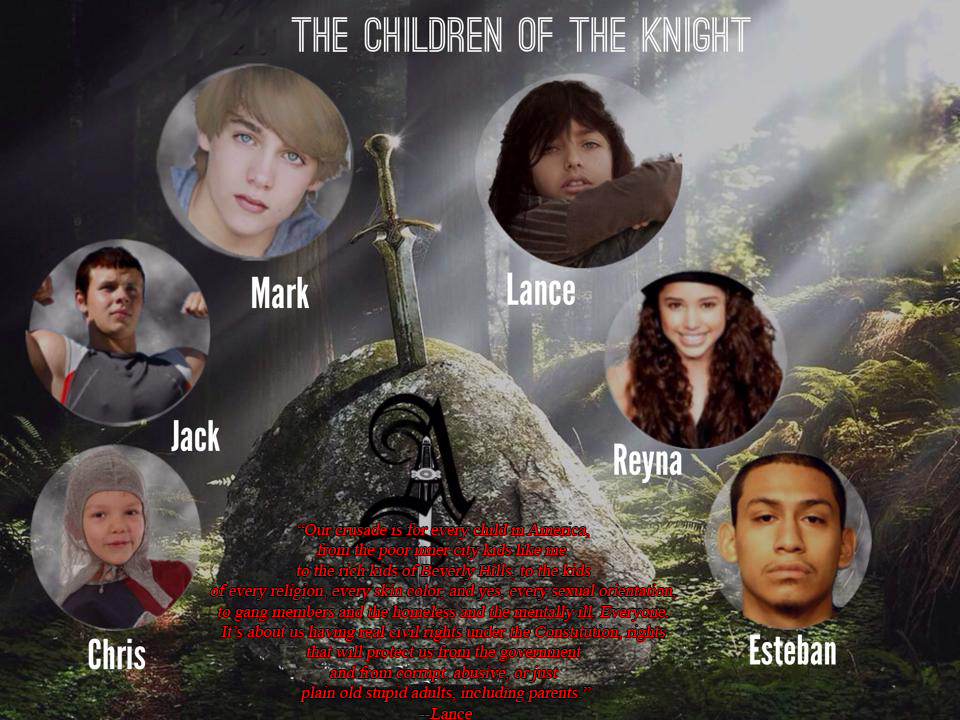
As an urban high school teacher for twenty-five years, I primarily taught kids of color. And yet, in the books and stories we read, almost all of the characters were Caucasian, and most with reasonably stable home lives. I decided as an author to write about the kids I knew best – kids of color, gay kids, marginalized kids, poor kids, kids with disabilities, gang members, and incarcerated kids – because I want all youth to see themselves represented in a positive light within the pages of teen literature.
To that end, I crafted a five-book series called The Children of the Knight Cycle that takes a fantasy concept – King Arthur in modern-day Los Angeles – and uses it to showcase a laundry list of crimes this society perpetrates against kids who don’t “fit the norm,” or won’t be shoehorned into the “one size fits all” mentality of public education, or don’t want to be a mini-me version of their parents. Virtually all the main characters in my series are teens of color, including Native Americans. Some of them are gay. But all are dynamic, memorable individuals that readers can relate to. Every day in America such kids are kicked to the curb. We don’t want them in our homes or classrooms or in our books. We’d rather they just disappear. In recent decades, we’ve decided we like putting them in prison. A staggering number of states arrest children aged ten (and younger) and charge them as adults for imitating the anti-social examples of adults, or for copying illicit behaviors popular media models every day.
I present these kids as real human beings with the same hopes, fears, needs, and wants as everyone else. My characters benefit from adults who choose to love them no matter what and who show them how to do what’s right, rather than what’s easy. The kids learn that every one of them can make a positive difference in this world, and that’s a message the students in my urban, working-class high school seldom got from the books I was forced to teach them. In those books, only “white” kids succeeded.
In my teen horror thriller, Spinner, I highlight the other forgotten kids I taught for many years – those with disabilities. These kids tend to be the most overlooked of all high schoolers because it is “assumed” by adults that they will never amount to much in life. Kids with physical or learning disabilities are no different from those without them – they can learn and achieve, but maybe not in the same cookie-cutter fashion school systems like to employ. I know what I’m talking about because I have a disability of my own – hearing loss. I’ve lived with a severe sensorineural hearing impairment my whole life, and did not have access to hearing aids until I was in college.
I also didn’t know anyone with hearing loss until after graduate school. I was the only kid like me, and that kind of singularity can be isolating. Even though people don’t always mean to be insensitive, not a single day went by that I wasn’t made to feel “different” because of my disability. On the plus side, my isolated childhood gave me true empathy for every youngster who was “different” in some way, and likely directed me to seek out such kids and work with them. After graduate school, I joined the Big Brothers Big Sisters program, wherein adults mentor kids with no father in the home. I was matched to a 14-year-old boy with hearing loss, and the experience was revelatory. Even as an adult, the relief that I felt to finally know someone who grew up with hearing loss was palpable. Imagine what it’s like for kids like me to see themselves in books they read, to understand that they aren’t alone or broken or crippled, to see hope for their lives because they see others like them achieving greatness. We all need to know that being different is not wrong. In fact, being apart from the norm is most often a net positive. But, my disability never defined me, and I want kids to see that theirs don’t define them, either.
I think publishers are skittish about books like mine that mash up various genres and focus on outside-the-box characters, stories that don’t fit an established pattern that can be “pitched” easily, and can’t be described as “the next Hunger Games” or something of that nature. Children of the Knight was released by an indie publisher that seemingly lost faith in the project because there was no visible attempt to promote it to the target audience. They even labeled it a romance on Amazon and it’s not a romance. I made a big push with Spinner to engage the interest of an agent or larger publisher and got nowhere with either. An indie publisher, YoungDudes Publishing, saw potential in the book and chose to release it. As a startup, they have no budget for promotion, but they are awesome people and working with them has been wonderful. But without the marketing arm of a big publisher, without those necessary journal reviews, like School Library Journal, nobody knows the book exists. This is the dilemma every writer must face, especially if, like me, you write outside the box and outside the genre mold.
Having said that, I would not change what I write to fit those molds or to make my books more “white,” assuming that is the goal with publishers. The main character in Spinner is Caucasian, but his friends are kids of color and they all have various disabilities. I took an interesting class last year about cover art on books for teens and children, and learned that even if the main character in those books was a child of color, the cover had been whitewashed in some fashion so the race or ethnicity was obscured. That class opened my eyes to how the publishing industry works and maybe showed me that, just as I never did in life, I might never fit into their predetermined “molds.”
One reviewer of my Children of the Knight series applauded me for breaking the teen hero mold by presenting a strong teen boy who is conflicted about his sexual orientation: “Lance is the hero around which the action pivots. Not many authors would have given such a character the heartthrob role. But Bowler takes a chance, fashioning something completely different by having such a key figure question his sexuality.”
I suspect a major publisher would have told me to “make him straight” like every other teen boy hero. I never had the chance to make such a choice, but I hope I would have said no. Lance is far more interesting and real for his inner turmoil, and for his desire to “fit in” the way society says he must in order to be a “real” boy.
No matter what we look like or how much money we have or how smart we are; no matter our race, ethnicity, gender, or orientation; no matter our abilities or disabilities – at the end of every day we’re all the same. We’re all human. We’re human first, and everything else second. We spend way too much time in this country focusing on what we perceive to be the weaknesses or differences in others. The teen characters in my books prove that our strengths always outweigh our weaknesses, and our diversity, i.e. our differentness, is to be celebrated, not hidden away. If more adults would focus on the natural talents and gifts of kids instead of always trying to make everyone “fit in,” then all children would have a real chance to soar. As a writer of teen lit, my goal is to empower every kid, not just the ones most Americans “look like” or even “act like.”









